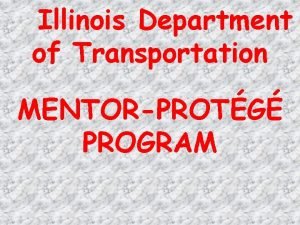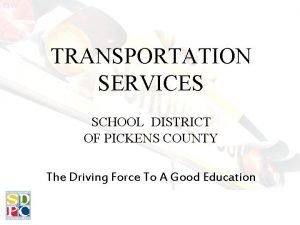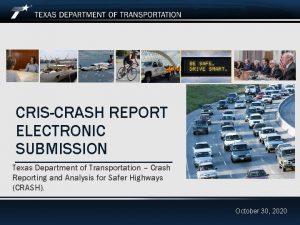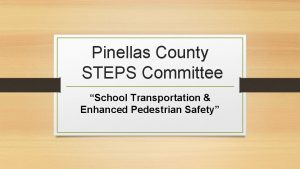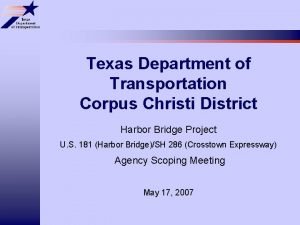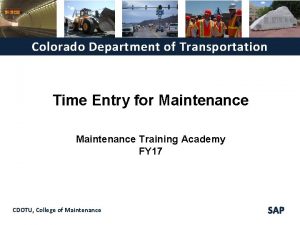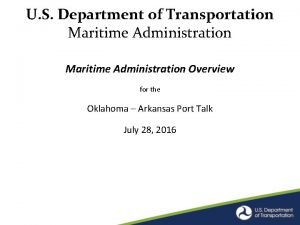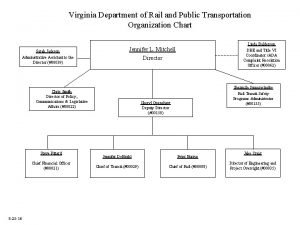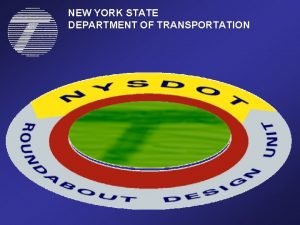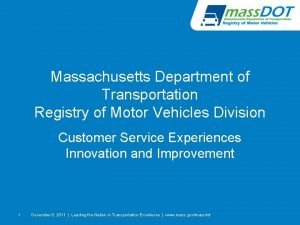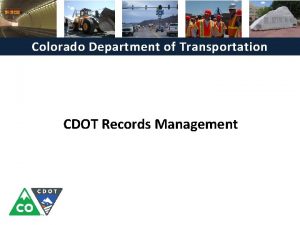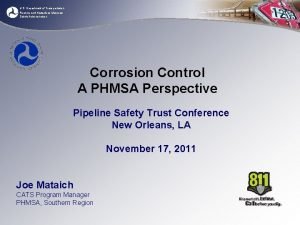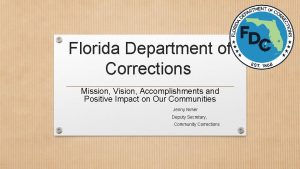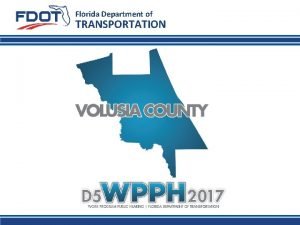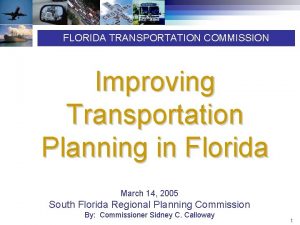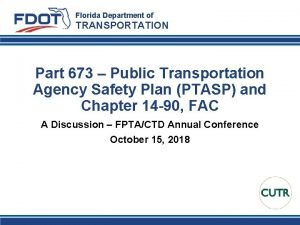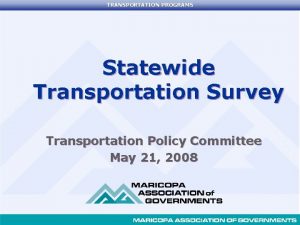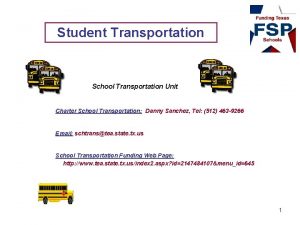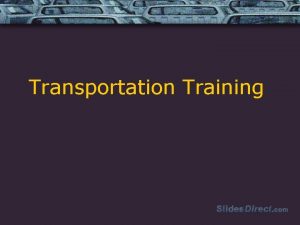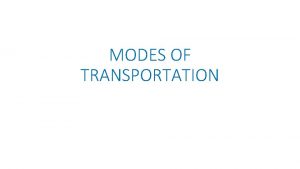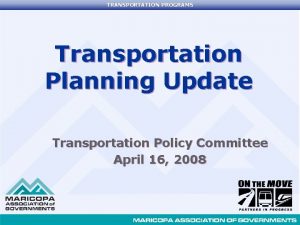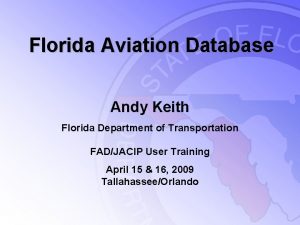Florida Department of TRANSPORTATION FLORIDA DEPARTMENT OF TRANSPORTATION





















- Slides: 21

Florida Department of TRANSPORTATION FLORIDA DEPARTMENT OF TRANSPORTATION Crash Cushion and Guardrail Approach Terminal In-Service Performance Evaluation (ISPE) Rudy Powell, P. E. , Director, Office of Maintenance FDOT Maintenance Conference May 2016 Orlando, FL

In-Service Performance Evaluations Road Map • • • What are In-Service Performance Evaluations (ISPE)? Why perform ISPEs? How will ISPEs be performed? How will the data be collected? What is E-Maintenance?

What are ISPEs? In-Service Performance Evaluations are the gathering and evaluation of data to assess the safety performance of crash cushions and guardrail approach terminals that have been installed on roads. These evaluations will be performed thru the joint efforts of the Safety, Design, Traffic Operations, Program Management, and Maintenance Offices.

Why perform ISPEs? On September 11, 2015, the Federal Highway Administration (FHWA) released the findings of the FHWA-AASHTO Joint Task Force in a report titled, “Report from Joint AASHTO-FHWA Task Force on Guardrail Terminal Crash Analysis. ” One of the recommendations in the findings was to conduct inservice performance evaluations of guardrail approach terminals that have been installed on roads. Based on this recommendation, the Department will move forward with performing in-service performance evaluations.

How will ISPEs be performed? In-Service Performance Evaluations consist of three phases. • Phase 1. Collection of Inventory Data. • Phase 2. Collection of Incident Data. • Phase 3. Evaluation of Data. In-Service Performance Evaluations are the gathering and evaluation of data to assess the safety performance of crash cushions and guardrail approach terminals that have been installed on roads.

Phase 1 - Inventory Data • Approach terminals. Collected by in-house or contract maintenance forces as part of the guardrail inspection performed every two years. • Crash Cushions. Collected by in-house or contract maintenance forces as part of the crash cushion inspections performed every year. • Inventory data is type (manufacturer, make, model), location, and photos. • Training is planned for October 2016. • Implementation is planned for January 1, 2017.

Phase 2 - Incident Data • Collected by in-house or contract maintenance forces. • If an incident occurs within the limits of a Traffic Monitoring Center (TMC), the TMC will determine if a guardrail approach terminal or crash cushion is impacted and if so, notify the appropriate maintenance office contacts. • If an incident occurs outside the limits of a TMC, law enforcement will notify the appropriate maintenance office contacts and the maintenance office will determine if a guardrail approach terminal or crash cushion is impacted.

Phase 2 - Incident Data (continued) • Maintenance forces will collect the data, ideally, before the vehicles involved in the incident are removed from the site, but at least prior to repair or replacement of the end terminal or crash cushion. • Incident data is crash report information plus addition data (over/ under/ through, location of impact, and photos). • Training is planned for October 2016. • Implementation is planned for January 1, 2017.

Phase 3 - Evaluation of Data • Phase 3 is the evaluation of the data collected from Phase 1 and Phase 2. • Evaluation will be performed by a third party such as a university or research facility and is not anticipated to start for several years.

How will ISPEs be performed? In-Service Performance Evaluations consists of three phases. • Phase 1. Collection of Inventory Data. Maintenance • Phase 2. Collection of Incident Data. Maintenance • Phase 3. Evaluation of Data. Third Party- University In-Service Performance Evaluations are the gathering and evaluation of data to assess the safety performance of crash cushions and guardrail approach terminals that have been installed on roads.

Statewide Maintenance Task Team A Guardrail Approach Terminal and Crash Cushion In. Service Performance Evaluation Statewide Maintenance Task Team has been formed to discuss and finalize the implementation details. These individuals are working within their district and will be the face of ISPEs in their district. These individuals will participate in training hosted by the Roadway Design and Product Evaluation Offices and take that information and knowledge back to each district.

Statewide Task Team District In-Service Performance Evaluation CO Rudy Powell CO Kirk Hutchison CO Kristin Mc. Crary CO Dale Cook/ Tim Allen 1 Paul Barnes 2 Paul Grochowski 3 Windle Tharp 4 Zachary Taylor 5 Barry Hallman 6 David Calhoun 7 Pedro Lopez TP Trevor Colley

How will this Data be collected? Option 1 • • • Clipboards Paper Forms Pens and Pencils Camera Enter data into a database Option 2 • • • Mobile Devices- tablets or smart phones Electronic Forms Statewide reportable database E-Maintenance!

Florida Department of TRANSPORTATION FLORIDA DEPARTMENT OF TRANSPORTATION E-Maintenance Rudy Powell, P. E. , Director, Office of Maintenance FDOT Maintenance Conference May 2016 Orlando, FL

E-Maintenance is the use of mobile devices coupled with software applications as tools to perform maintenance work in a more efficient, streamlined manner; in a paperless, cloud environment; and with statewide data reporting capabilities.

E-Maintenance consists of two phases. • Phase 1. Inventory, inspection, and evaluation. – – Roadway Characteristics Inventory (RCI). Sign, guardrail, and crash cushion inspections. Rest Area Inspections. Maintenance Rating Program (MRP). • Phase 2. Contract administration. The focus is currently Phase 1.

E-Maintenance Phase 1 - Inventory, Inspection, and Evaluation This work is currently performed using clipboards, standard paper forms, and pencils. Subsequent work is then necessary to file the standard form as a hardcopy; scan and file the standard form as an electronic file; and hard code the data written on the form into a database with limited statewide reporting capabilities. The focus is In-Service Performance Evaluations E-Maintenance Phase 1 is the use of mobile devices with GPS and camera capabilities, electronic forms which are app based portals to enter data in real time, and creation of a statewide reportable database.

E- Maintenance A Statewide E-Maintenance Task Team has been formed to establish direction, details, and implementation. These individuals are working within their district and will be the face of E-Maintenance in their district. • Mobile Devices. Tablets or smartphones. • Front End Mobile Application. Software development and support of electronic forms as mobile apps to allow electronic forms to be populated and at the same time allow the data to be uploaded in real time to a database. • Back End Database. Data is searchable, retrievable, and reportable. • Funding and budget. A possible grant thru FHWA is being reviewed for E-Operations.

E-Maintenance District CO CO 1 2 3 4 5 6 7 TP E-Maintenance Rudy Powell Kirk Hutchison Mike Soto Fred Noble Melody Joyner/ Erik Padron Barbara Brannon Jeff Barbee Lloyd Mc. Pherson Raul Artuz Bryan Holm Pedro Lopez Trevor Colley

ISPEs and E-Maintenance Summary In-Service Performance Evaluations Gathering and evaluation of data to assess the safety performance. Phase 1. Collection of Inventory Data. Phase 2. Collection of Incident Data. Phase 3. Evaluation of Data. Joint effort between Traffic Operations, Design, Safety, Program Management, and Maintenance Offices. • Statewide maintenance task team. • • • E-Maintenance • • Mobile devices, front end apps, back end reportable statewide database. Phase 1. Inventory, inspection, and evaluation. Phase 2. Contract administration. Statewide maintenance task team.

Florida Department of TRANSPORTATION Questions/ Comments? For more information contact: Rudy Powell, P. E. Director, Office of Maintenance Florida Department of Transportation (850) 410 -5656 rudy. powell@dot. state. fl. us
 Department of transportation
Department of transportation Montana department of transportation
Montana department of transportation Pickens county bus office
Pickens county bus office Maricopa county department of transportation
Maricopa county department of transportation Cris txdot
Cris txdot Seminole transportation
Seminole transportation Pcsb transportation
Pcsb transportation Department of transportation
Department of transportation Texas department of transportation corpus christi
Texas department of transportation corpus christi Department of transportation
Department of transportation Department of transportation
Department of transportation Us department of transportation maritime administration
Us department of transportation maritime administration Virginia department of rail and public transportation
Virginia department of rail and public transportation How many roundabouts in new york
How many roundabouts in new york Massachusetts department of motor vehicles
Massachusetts department of motor vehicles Department of transportation
Department of transportation Department of transportation
Department of transportation Phmsa okc
Phmsa okc Florida department of agriculture and consumer services
Florida department of agriculture and consumer services State of florida department of juvenile justice
State of florida department of juvenile justice Florida department of corrections mission statement
Florida department of corrections mission statement Pyramid scheme vs ponzi
Pyramid scheme vs ponzi
